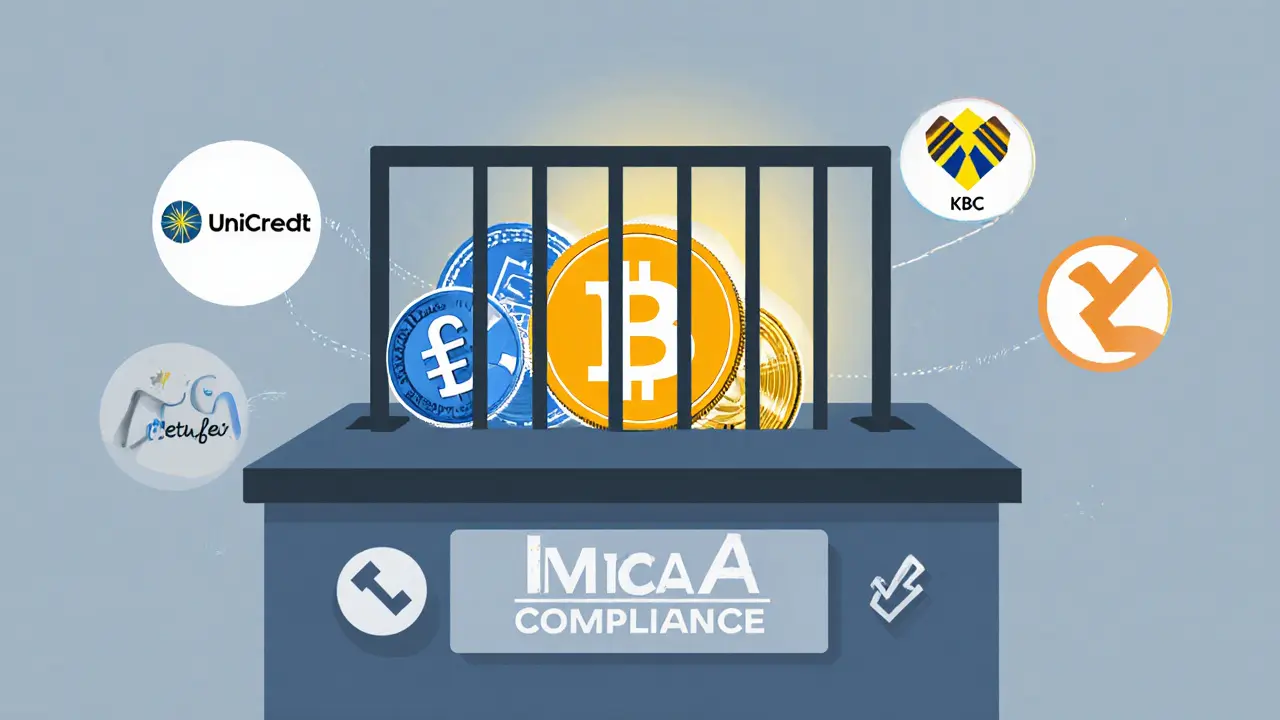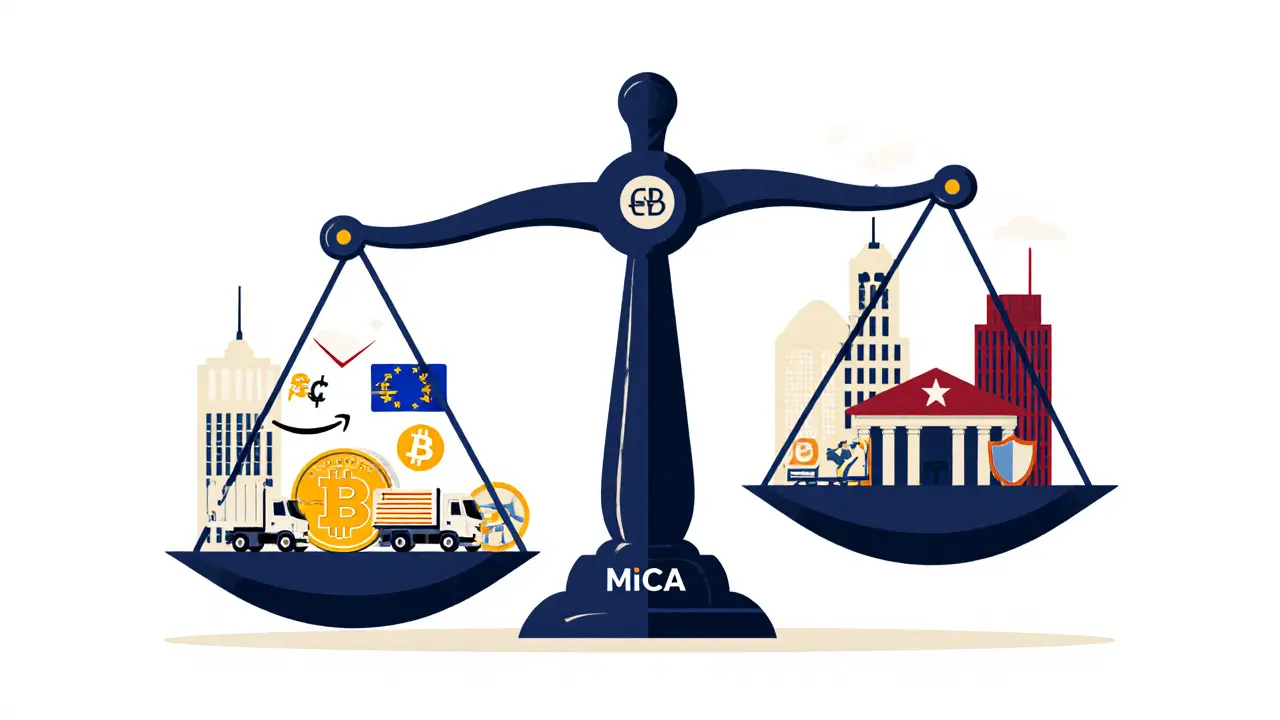EU Stablecoin Restrictions Explained: What USDT and Other Tokens Can No Longer Do in Europe
 Apr, 30 2025
Apr, 30 2025
As of early 2025, if you’re holding USDT in the European Union, you can’t trade it on any major exchange anymore. Not because it’s broken. Not because it’s unsafe. But because it doesn’t follow the EU’s new rules. The EU stablecoin restrictions under MiCA - the Markets in Crypto-Assets Regulation - have reshaped what’s allowed in Europe’s digital asset market. And for users, traders, and investors, that means real changes - not just headlines.
What MiCA Actually Does
MiCA isn’t a vague warning. It’s a full legal framework that came into force in January 2025. It doesn’t ban stablecoins. It bans non-compliant ones. That’s the key difference. The regulation splits stablecoins into two clear categories: Asset-Referenced Tokens (ARTs) and E-Money Tokens (EMTs). Both have to meet strict standards to operate legally in the EU.For EMTs - like a digital euro - the rules are simple: every token must be backed 1:1 by cash or cash equivalents. No shortcuts. No risky investments. No lending out reserves. The money backing the token must be held in a separate, bankruptcy-protected account. That means if the issuer goes under, your euros are still safe.
ARTs, which include multi-asset stablecoins, face similar rules. They must maintain full reserves, disclose exactly what’s backing them, and allow holders to redeem their tokens for the underlying value at any time. No delays. No fees. No excuses.
That’s the core of MiCA: transparency, safety, and control. The EU didn’t want another Terra or Celsius collapse. They wanted stablecoins that behave like real money - not speculative bets.
Why USDT Can’t Trade in the EU Anymore
Tether, the company behind USDT, hasn’t met MiCA’s requirements. And they haven’t applied for authorization. That’s not because they can’t - it’s because they haven’t. USDT’s reserves have historically included commercial paper, corporate bonds, and even some illiquid assets. MiCA doesn’t allow that. Only cash, government bonds, or deposits at regulated banks are permitted.ESMA, the EU’s financial watchdog, gave CASPs - crypto exchanges and trading platforms - until January 31, 2025, to delist all non-compliant tokens. By March 2025, every EU member state had enforced the ban. So if you’re in Germany, France, or Spain, you can’t buy, sell, or swap USDT on Binance, Kraken, or any other licensed platform.
You can still hold it. You can still transfer it to a personal wallet. But you can’t trade it. That kills liquidity. And without liquidity, USDT becomes useless for most traders who rely on it to move in and out of crypto positions quickly.
What About Other Stablecoins?
USDT isn’t alone. USDC, despite being more transparent than Tether, also hasn’t applied for MiCA compliance as an EMT. Circle, its issuer, is focusing on U.S. regulatory approval under the GENIUS Act instead. That means USDC is also blocked from trading on EU exchanges.Other stablecoins like BUSD, DAI, and FRAX are similarly affected. DAI, for example, relies on a complex system of crypto collateral. MiCA requires cash-backed reserves - not volatile assets. So DAI doesn’t qualify either.
The only stablecoins currently allowed on EU platforms are those that have gone through the full authorization process. So far, that’s mostly euro-denominated tokens issued by licensed e-money institutions. Think of them as digital euros - same value, same rules as traditional bank money, just on a blockchain.

The European Bank Consortium Is Building a Real Alternative
The EU isn’t just shutting down U.S. stablecoins - it’s building its own. Nine major European banks, including ING, UniCredit, KBC, and Danske Bank, have formed a consortium to launch a MiCA-compliant euro stablecoin. They’ve incorporated a new entity in the Netherlands and are seeking approval from the Dutch Central Bank as an e-money institution.This isn’t a side project. It’s strategic. The consortium says they want to give Europe “a real alternative to U.S.-dominated stablecoins.” Their goal? To power instant, 24/7 cross-border payments using blockchain, while keeping control of the financial system within the EU.
The token is expected to launch in late 2026. Once live, it could become the default stablecoin for EU-based DeFi apps, payment processors, and even retail banking services. That’s a huge shift. Instead of relying on Tether or Circle, Europeans will use a token issued by their own banks.
How This Compares to the U.S.
The U.S. is going a different route. In July 2025, President Trump signed the GENIUS Act - the Guiding and Establishing National Innovation for U.S. Stablecoins Act. Like MiCA, it requires 1:1 backing and bankruptcy protection. But here’s the difference: the U.S. gives issuers more time. It allows more flexibility in reserve composition. And it explicitly labels compliant stablecoins as “payment stablecoins,” giving them legal status alongside traditional e-money.Visa and Mastercard are already integrating U.S.-issued stablecoins into their payment rails. Walmart and Amazon are testing them for merchant payouts. The U.S. isn’t trying to control stablecoins - it’s trying to dominate them.
That creates a real divide. If you’re a trader in the EU, your options are limited. If you’re in the U.S., you’ve got more choices - and more speed. Analysts warn this could lead to capital flight. Businesses might move their crypto operations to the U.S. just to access better liquidity.

What This Means for You
If you’re an EU resident holding USDT or other non-compliant stablecoins:- You can’t trade them on exchanges anymore.
- You can still send them to your wallet - but you won’t be able to cash out easily within the EU.
- If you need liquidity, convert to EUR-backed tokens like the upcoming euro stablecoin or use a licensed fiat gateway.
- Don’t assume you can use a VPN to bypass restrictions - exchanges now require KYC tied to your EU address.
If you’re a business using stablecoins for payments:
- Start transitioning to MiCA-compliant tokens now.
- Work with payment providers that support euro-denominated stablecoins.
- Expect slower cross-border settlements if you’re still using USDT - because the liquidity chains are broken.
The bottom line: the EU isn’t anti-crypto. It’s pro-safety. It’s not trying to kill innovation - it’s trying to make sure innovation doesn’t put your money at risk.
What’s Next?
The next 12 months will be critical. The euro stablecoin from the bank consortium is expected to launch in late 2026. If it works well, it could become the backbone of Europe’s digital payments. If it fails, the EU might loosen some rules - but don’t expect a return to the old wild west.Meanwhile, the U.S. will keep pushing ahead with its more permissive model. That means global crypto markets are splitting into two zones: one regulated tightly for safety, the other optimized for speed and scale.
For users, the choice is simple: adapt or get left behind. The EU has spoken. Now it’s up to you to decide how to move forward.
Can I still hold USDT in the EU after the ban?
Yes, you can still hold USDT in your personal wallet. The MiCA ban only stops trading and exchange services. You won’t be fined for holding it. But you won’t be able to sell it on any licensed EU platform, and converting it to euros will be harder and more expensive.
Why can’t USDT just comply with MiCA?
Tether’s reserves include commercial paper, corporate bonds, and other non-cash assets. MiCA requires 100% cash or cash equivalents - no exceptions. Tether would have to completely overhaul its reserve structure, which would cost billions and reduce profits. So far, they’ve chosen not to make that change.
Is there a legal way to trade USDT in the EU now?
No. All licensed Crypto-Asset Service Providers (CASPs) in the EU are legally required to delist non-compliant stablecoins. Even peer-to-peer trading through unregulated platforms carries legal risk. If you’re caught using a non-compliant token for commercial purposes, you could face penalties under national anti-money laundering laws.
What stablecoins are allowed in the EU now?
Only stablecoins authorized as E-Money Tokens (EMTs) under MiCA. As of now, no major U.S.-based stablecoin has received this authorization. The first compliant token expected to launch is a euro-denominated stablecoin from a consortium of nine European banks, set for late 2026.
Will the EU ban other cryptocurrencies too?
No. MiCA only targets stablecoins and asset-referenced tokens. Bitcoin, Ethereum, and other non-stable crypto assets are still fully legal and tradable in the EU. The regulation is focused on protecting consumers from the specific risks of stablecoins - not on banning crypto as a whole.
How will this affect DeFi in the EU?
It will force DeFi platforms to adapt. Many DeFi protocols used USDT or USDC as liquidity pools. Now, they’re switching to euro-backed stablecoins or moving operations outside the EU. Some EU-based DeFi projects are already building MiCA-compliant versions. But innovation is slowing down because of the compliance burden.
Caren Potgieter
November 23, 2025 AT 05:34Matthew Prickett
November 24, 2025 AT 11:05jocelyn cortez
November 24, 2025 AT 20:58Omkar Rane
November 25, 2025 AT 20:57